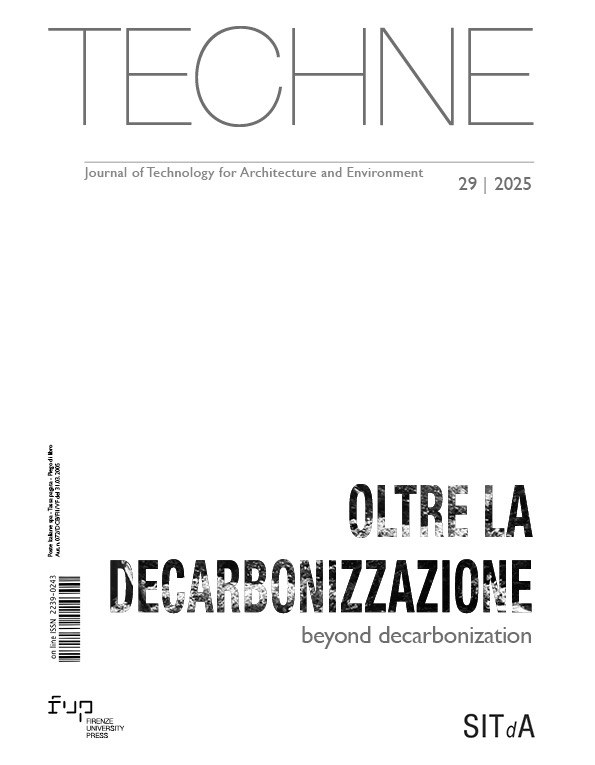Published 2025-07-31
Keywords
- Generative artificial intelligence,
- Sustainable-Aided Design,
- Data-Driven,
- Decarbonisation,
- Methodology
How to Cite
Copyright (c) 2025 Angelo Figliola, Maurizio Barberio

This work is licensed under a Creative Commons Attribution 4.0 International License.
Abstract
The recent introduction of Generative Artificial Intelligence tools in architectural design has simultaneously opened new possibilities and raised questions about their appropriate use in holistic design processes, such as those related to environmental design. Avoiding the uncritical adoption of these tools is essential in a post-decarbonisation context, where the goal is to drastically reduce CO2 emissions and promote regenerative practices. Therefore, this paper proposes an operational methodology that integrates such tools within Sustainable-Aided Design, a holistic approach aimed at bridging the gap between architectural design and environmental design from the ultra-early stage of the design process.
Downloads
References
- Choi, S. and Yoon, S. (2024), “GPT-based data-driven urban building energy modelling (GPT-UBEM): Concept, methodology, and case studies”, Energy and Buildings, Vol. 325, p. 115042. Available at: https://doi.org/10.1016/j.enbuild.2024.115042 (Accessed on 18/11/2024). DOI: https://doi.org/10.1016/j.enbuild.2024.115042
- del Campo, M. (2022), Neural Architecture: Design and Artificial Intelligence, Applied Research and Design Publishing. DOI: https://doi.org/10.4324/9781003183181-8
- del Campo, M. and Leach, N. (2022), Machine Hallucinations: Architecture and Artificial Intelligence, John Wiley & Sons. Available at: https://onlinelibrary.wiley.com/toc/15542769/2022/92/3 (Accessed on 06/09/2024).
- Ferrante, T. and Romagnoli, F. (2023), “Support or automation in decision-making: the role of artificial intelligence for the project”, TECHNE – Journal of Technology for Architecture and Environment, Vol. 25, pp. 68-77. Available at: https://doi.org/10.36253/techne-13713 (Accessed on 06/09/2024). DOI: https://doi.org/10.36253/techne-13713
- Galanos, T. (2019), “Machine-Learned Regenerative Design”, in Naboni, E. and Havinga, L. (Eds.), Regenerative Design in Digital Practice, Eurac Research, Bolzano, Italy, pp. 95-99. Available at: https://buildup.ec.europa.eu/sites/default/files/content/regenerative_design_in_digital_practice_small.pdf (Accessed on 06/09/2024).
- Guarini, M.R., Sica, F., Segura, A. (2024), “Artificial Intelligence (AI) Integration in Urban Decision-Making Processes: Convergence and Divergence with the Multi-Criteria Analysis (MCA)”, Information, Vol. 15, n. 11, pp. 678. Available at: https://doi.org/10.3390/info15110678 (Accessed on 18/11/2024). DOI: https://doi.org/10.3390/info15110678
- Karimi, H., Adibhesami, M.A., Hoseinzadeh, S., Salehi, A., Groppi, D. and Astiaso Garcia, D. (2024), “Harnessing Deep Learning and Reinforcement Learning Synergy as a Form of Strategic Energy Optimization in Architectural Design: A Case Study in Famagusta, North Cyprus”, Buildings, Vol. 14, n. 5, p. 1342. Available at: https://doi.org/10.3390/buildings14051342 (Accessed on 06/09/2024). DOI: https://doi.org/10.3390/buildings14051342
- Płoszaj-Mazurek, M., Rynska, E. (2024), “Artificial Intelligence and Digital Tools for Assisting Low-Carbon Architectural Design: Merging the Use of Machine Learning, Large Language Models, and Building Information Modeling for Life Cycle Assessment Tool Development”, Energies, Vol. 17, n.12, p. 2997. Available at: https://doi.org/10.3390/en17122997 (Accessed on 06/09/2024). DOI: https://doi.org/10.3390/en17122997
- Rane, N. (2023), “ChatGPT and similar generative artificial intelligence (AI) for building and construction industry: Contribution, opportunities and challenges of large language models for Industry 4.0, Industry 5.0, and Society 5.0”, SSRN. Available at: 10.2139/ssrn.4603221 (Accessed on 06/09/2024). DOI: https://doi.org/10.2139/ssrn.4603221
- Vissers-Similon, E., Dounas, T. and De Walsche, J. (2024), “Classification of artificial intelligence techniques for early architectural design stages”, International Journal of Architectural Computing. Available at: https://doi.org/10.1177/14780771241260 (Accessed on 06/09/2024).
- Yahaya, H.L., Vivek, S.M., Shehu, U.M. and Auwal, A.M. (2022), “Carbon footprint management: A review of construction industry”, Clean. Eng. Technol., Vol. 9, p. 100531. Available at: https://doi.org/10.1016/j.clet.2022.100531 (Accessed on 06/09/2024). DOI: https://doi.org/10.1016/j.clet.2022.100531






